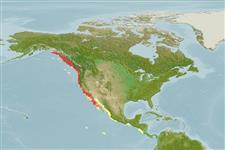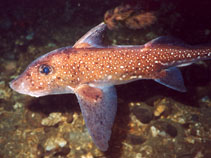Hydrolagus colliei (Lay & Bennett, 1839)
Spotted ratfish
Добавить Ваши наблюдения в Fish Watcher
| Native range | All suitable habitat | Point map | Year 2050 |

|
| This map was computer-generated and has not yet been reviewed. |
| Hydrolagus colliei AquaMaps Data sources: GBIF OBIS |
Загрузить свой Фото и Видео
Pictures | Videos | Изображение на GoogleHydrolagus colliei
Picture by Nichols, J.
Pictures | Videos | Изображение на GoogleHydrolagus colliei
Picture by Nichols, J.
United States (contiguous states) country information
Common names:
Ratfish, Spotted ratfish, Spotted rattfish
Occurrence: native
Salinity: marine
Abundance: | Ref:
Importance: | Ref:
Aquaculture: | Ref:
Regulations: | Ref:
Uses: no uses
Comments: Occurs in Monterey Bay (Ref. 12091). Common on sandy beaches in Puget Sound, Washington in 1895 (Ref. 28609). Also Ref. 4925, 6793.
National Checklist:
Country Information: https://www.cia.gov/library/publications/resources/the-world-factbook/geos/us.html
National Fisheries Authority: http://www.nmfs.gov
Occurrences: Occurrences Point map
Main Ref: Eschmeyer, W.N., E.S. Herald and H. Hammann, 1983
National Database:
Occurrence: native
Salinity: marine
Abundance: | Ref:
Importance: | Ref:
Aquaculture: | Ref:
Regulations: | Ref:
Uses: no uses
Comments: Occurs in Monterey Bay (Ref. 12091). Common on sandy beaches in Puget Sound, Washington in 1895 (Ref. 28609). Also Ref. 4925, 6793.
National Checklist:
Country Information: https://www.cia.gov/library/publications/resources/the-world-factbook/geos/us.html
National Fisheries Authority: http://www.nmfs.gov
Occurrences: Occurrences Point map
Main Ref: Eschmeyer, W.N., E.S. Herald and H. Hammann, 1983
National Database:
Common names from other countries
Классификация / Names народные названия | синонимы | Catalog of Fishes(род, виды) | ITIS | CoL | WoRMS | Cloffa
Цельноголовые (химеры) (chimaeras) > Chimaeriformes (Chimaeras) > Chimaeridae (Shortnose chimaeras or ratfishes)
Etymology: Hydrolagus: hydro-, combining form of hydor (Gr.), water; lagos (Gr.), hare, i.e., “water rabbit,” probably referring to three pairs of tooth plates, which tend to protrude from the mouth like a rabbit’s incisors (See ETYFish); colliei: In honor of Alexander Collie (1793‒1835), Scottish surgeon-naturalist aboard HMS Blossom, from which holotype was collected; his notes formed the basis of Lay & Bennett’s description (See ETYFish).
Eponymy: Lieutenant Dr Alexander Collie (1793–1835) was the naval surgeon and naturalist on an expedition (1825–1828) led by Captain Frederick Beechey on ‘HMS Blossom’. [...] (Ref. 128868), visit book page.
More on authors: Lay & Bennett.
Etymology: Hydrolagus: hydro-, combining form of hydor (Gr.), water; lagos (Gr.), hare, i.e., “water rabbit,” probably referring to three pairs of tooth plates, which tend to protrude from the mouth like a rabbit’s incisors (See ETYFish); colliei: In honor of Alexander Collie (1793‒1835), Scottish surgeon-naturalist aboard HMS Blossom, from which holotype was collected; his notes formed the basis of Lay & Bennett’s description (See ETYFish).
Eponymy: Lieutenant Dr Alexander Collie (1793–1835) was the naval surgeon and naturalist on an expedition (1825–1828) led by Captain Frederick Beechey on ‘HMS Blossom’. [...] (Ref. 128868), visit book page.
More on authors: Lay & Bennett.
Environment: milieu / climate zone / depth range / distribution range экология
морской батидемерсальный; пределы глубины 0 - 913 m (Ref. 6793), usually 50 - 400 m (Ref. 43939). Temperate; 59°N - 8°N, 141°W - 83°W
распространение страны | регионы FAO | Ecosystems | места находок | Point map | интродукции | Faunafri
Northeastern Pacific: west coast of North America from southwestern Alaska to Baja California, Mexico, including the Gulf of California, and Costa Rica.
Length at first maturity / Size / Вес / Возраст
Краткое описание определительные ключи | морфология | морфометрия
This species is distinguished by the following characters: short and bluntly rounded snout; oral and preopercular lateral line canals not sharing a short common branch from the infraorbital canal; anterior edge of dorsal-fin spine non-serrated; anterior and posterior regions of second dorsal-fin considerably taller than the middle region; pectoral fins when depressed do not reach beyond to origin of pelvic fins; no anal fin; caudal-fin axis horizontal with the fin nearly symmetrical, epaxial
and hypaxial lobes equal sized; coloration brown or reddish brown with small white spots on head and trunk (Ref. 97389).
Found near the bottom, from close inshore to about 913 m (Ref. 2850). Abundant in cold waters at moderate depths. Feed on mollusks, crustaceans and fishes (Ref. 37955); also echinoderms and worms (Ref. 28499). The spine can be dangerous and cause a painful wound (Ref. 2850). Fishers are reputed to fear the jaws of the ratfish more than they do the dorsal spine. Its flesh is edible but bland and leaves an unpleasant aftertaste (Ref. 28499). The liver was used as a source of machine oil (Ref. 28499).
Life cycle and mating behavior половая зрелость | размножение | нерест | икра | Fecundity | личинки
Distinct pairing during copulation (Ref. 205). The female extrudes two eggs at a time (each contained in a capsule) and may take up to 30 hours to extrude all her egg cases, which then hang from her body on a long filament for another 4 to 6 days. The egg cases end up planted vertically in the mud or just lying with filaments entangled on the bottom. Females extruding egss can be found year-round (Ref. 28499).
Основная ссылка
Upload your references | ссылки | координатор | соавторы
Allen, M.J. and G.B. Smith, 1988. Atlas and zoogeography of common fishes in the Bering Sea and northeastern Pacific. NOAA Tech. Rep. NMFS 66, 151 p. (Ref. 6793)
Статус Красного Списка МСОП (Ref. 130435: Version 2024-2)
Не вызывающий беспокойства (LC) ; Date assessed: 04 May 2024
Использование человеком
рыболовство: интереса не представляет; объект спортивного рыболовства: да; аквариум: общественные аквариумы
FAO(рыболовство: production; publication : search) | FishSource | Sea Around Us
дополнительная информация
Population dynamics
Growth parameters
Max. ages / sizes
Length-weight rel.
Length-length rel.
Размерный состав
Mass conversion
пополнение
численность
Growth parameters
Max. ages / sizes
Length-weight rel.
Length-length rel.
Размерный состав
Mass conversion
пополнение
численность
Life cycle
размножение
половая зрелость
Fecundity
нерест
Spawning aggregations
икра
Развитие икры
личинки
динамика численности личинок
размножение
половая зрелость
Fecundity
нерест
Spawning aggregations
икра
Развитие икры
личинки
динамика численности личинок
Anatomy
жаберная область
Brain
Otolith
жаберная область
Brain
Otolith
Physiology
Body composition
Nutrients
Oxygen consumption
Swimming type
Swimming speed
Visual pigments
Fish sound
Diseases & Parasites
Toxicity (LC50s)
Body composition
Nutrients
Oxygen consumption
Swimming type
Swimming speed
Visual pigments
Fish sound
Diseases & Parasites
Toxicity (LC50s)
Human related
Aquaculture systems
особенности рыбоводства
степень растяжения
Ciguatera cases
Stamps, coins, misc.
Aquaculture systems
особенности рыбоводства
степень растяжения
Ciguatera cases
Stamps, coins, misc.
инструменты
Bio-Quiz | E-book | полевой определитель | определительные ключи | Длина-Частота | онтогенез | карта точек | Classification Tree
| Catch-MSY |
Специальные отчеты
Проверить содержание в аквариумах | Проверить опубликованные видовые данные | Проверить опубликованные данные по аквакультуре
Скачать в формате XML
ресурсы в Интернет
Aquatic Commons | BHL | Cloffa | Websites from users | Проверить FishWatcher | CISTI | Catalog of Fishes(род, виды) | DiscoverLife | ECOTOX | Faunafri | Fishtrace | GenBank(Геном, Нуклеотид) | GloBI | GOBASE | | Google Books | Google Scholar | Google | IGFA World Record | MitoFish | Otolith Atlas of Taiwan Fishes | общественные аквариумы | PubMed | Reef Life Survey | Scirus | SeaLifeBase | Tree of Life | Wikipedia(Вперёд, поиск) | World Records Freshwater Fishing | Zoological Record
Estimates based on models
Preferred temperature (Ref. 115969): 5.1 - 9.7, mean 7.5 (based on 115 cells).
Phylogenetic diversity index (Ref. 82804): PD50 = 0.5000 [Uniqueness, from 0.5 = low to 2.0 = high].
Bayesian length-weight: a=0.00331 (0.00137 - 0.00798), b=3.07 (2.86 - 3.28), in cm Total Length, based on LWR estimates for this (Sub)family-body shape (Ref. 93245).
Trophic level (Ref. 69278): 3.7 ±0.54 se; based on food items.
устойчивость к внешним воздействиям (Ref. 120179): низкий, минимальное время удвоения популяции 4.5-14 лет (K=0.2-0.22; Fec=2).
Fishing Vulnerability (Ref. 59153): Moderate to high vulnerability (50 of 100).
Climate Vulnerability (Ref. 125649): Moderate to high vulnerability (47 of 100).




